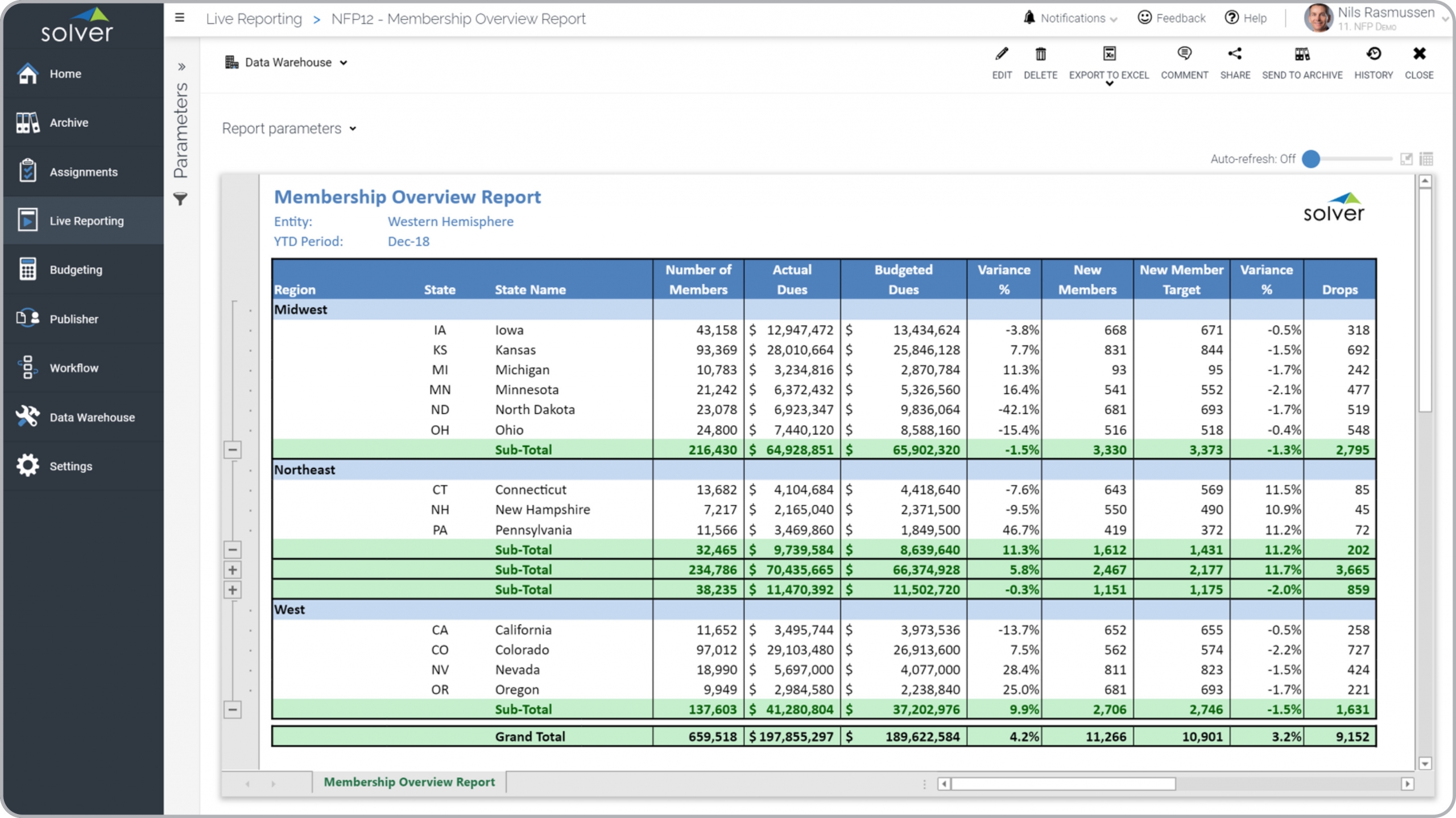Membership Analysis Report
What is
a
Membership Analysis Report
? Membership reports are considered analysis tools and are used by membership managers to monitor statistical and financial member metrics. Some of the key functionality in this type of report is that it can be run for any period and any organizational unit. The core of the report shows membership metrics by state and region with sub-totals and totals. The columns include Number of Members, Actual Dues, Budgeted Dues, Budget Variance, # of New Members, New Member Target, Variance and Drops. You find an example of this type of report below.
Purpose of
Membership Analysis Reports Nonprofits and associations use Membership Analysis Reports to monitor the organization's ability to meet its membership budgets and goals. When used as part of good business practices in a Financial Planning & Analysis (FP&A) and Membership department, an organization can improve its revenues and membership numbers as well as reduce the chances that attrition or other issues limits successful growth.
Membership Analysis Report
Example Here is an example of a Membership Report that compares financial and statistical metrics across geographic regions. [caption id="" align="alignnone" width="2560"]
 Membership Analysis Report Example[/caption] You can find hundreds of additional examples
here
Who Uses This Type of
Report
? The typical users of this type of report are: Membership managers, executives.
Other
Report
s Often Used in Conjunction with
Membership Analysis Reports Progressive Financial Planning & Analysis (FP&A) and Membership departments sometimes use several different Membership Analysis Reports, along with membership dashboards, financial statements, budget models and other management and control tools.
Where Does the Data for Analysis Originate From? The Actual (historical transactions) data typically comes from dedicated membership management systems or enterprise resource planning (ERP) systems like: Microsoft Dynamics 365 (D365) Finance, Microsoft Dynamics 365 Business Central (D365 BC), Microsoft Dynamics AX, Microsoft Dynamics NAV, Microsoft Dynamics GP, Microsoft Dynamics SL, Sage Intacct, Sage 100, Sage 300, Sage 500, Sage X3, SAP Business One, SAP ByDesign, Acumatica, Netsuite and others. In analyses where budgets or forecasts are used, the planning data most often originates from in-house Excel spreadsheet models or from professional corporate performance management (CPM/EPM) solutions.
What Tools are Typically used for Reporting, Planning and Dashboards? Examples of business software used with the data and ERPs mentioned above are:
Membership Analysis Report Example[/caption] You can find hundreds of additional examples
here
Who Uses This Type of
Report
? The typical users of this type of report are: Membership managers, executives.
Other
Report
s Often Used in Conjunction with
Membership Analysis Reports Progressive Financial Planning & Analysis (FP&A) and Membership departments sometimes use several different Membership Analysis Reports, along with membership dashboards, financial statements, budget models and other management and control tools.
Where Does the Data for Analysis Originate From? The Actual (historical transactions) data typically comes from dedicated membership management systems or enterprise resource planning (ERP) systems like: Microsoft Dynamics 365 (D365) Finance, Microsoft Dynamics 365 Business Central (D365 BC), Microsoft Dynamics AX, Microsoft Dynamics NAV, Microsoft Dynamics GP, Microsoft Dynamics SL, Sage Intacct, Sage 100, Sage 300, Sage 500, Sage X3, SAP Business One, SAP ByDesign, Acumatica, Netsuite and others. In analyses where budgets or forecasts are used, the planning data most often originates from in-house Excel spreadsheet models or from professional corporate performance management (CPM/EPM) solutions.
What Tools are Typically used for Reporting, Planning and Dashboards? Examples of business software used with the data and ERPs mentioned above are:
- Native ERP report writers and query tools
- Spreadsheets (for example Microsoft Excel)
- Corporate Performance Management (CPM) tools (for example Solver)
- Dashboards (for example Microsoft Power BI and Tableau)
Corporate Performance Management (CPM) Cloud Solutions and More Examples
December 9, 2020
TAGS:
Reporting,
Solver,
report writer,
Microsoft,
member,
template,
practice,
Acumatica,
dues,
Netsuite,
Finance,
GP,
nonprofit,
Business Central,
excel,
membership,
ax,
Budget,
Dynamics 365,
target,
revenue,
NFP,
Cloud,
Software,
not-for-profit,
Tableau,
SAP,
example,
association,
best,
organization,
Sage,
BC,
D365,
NAV,
Intacct,
Variance,
CPM,
report,
SL,
Management,
dynamics,
Power BI

